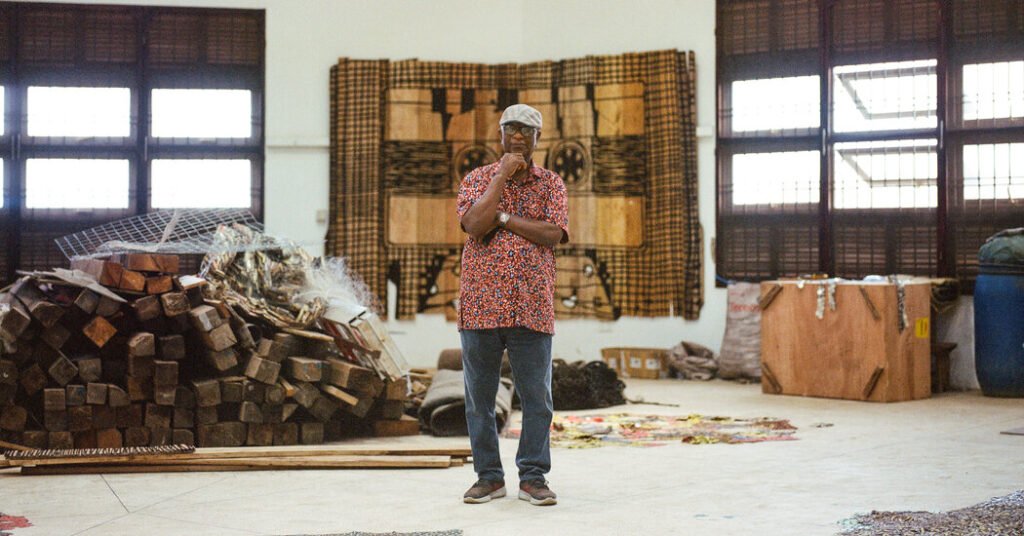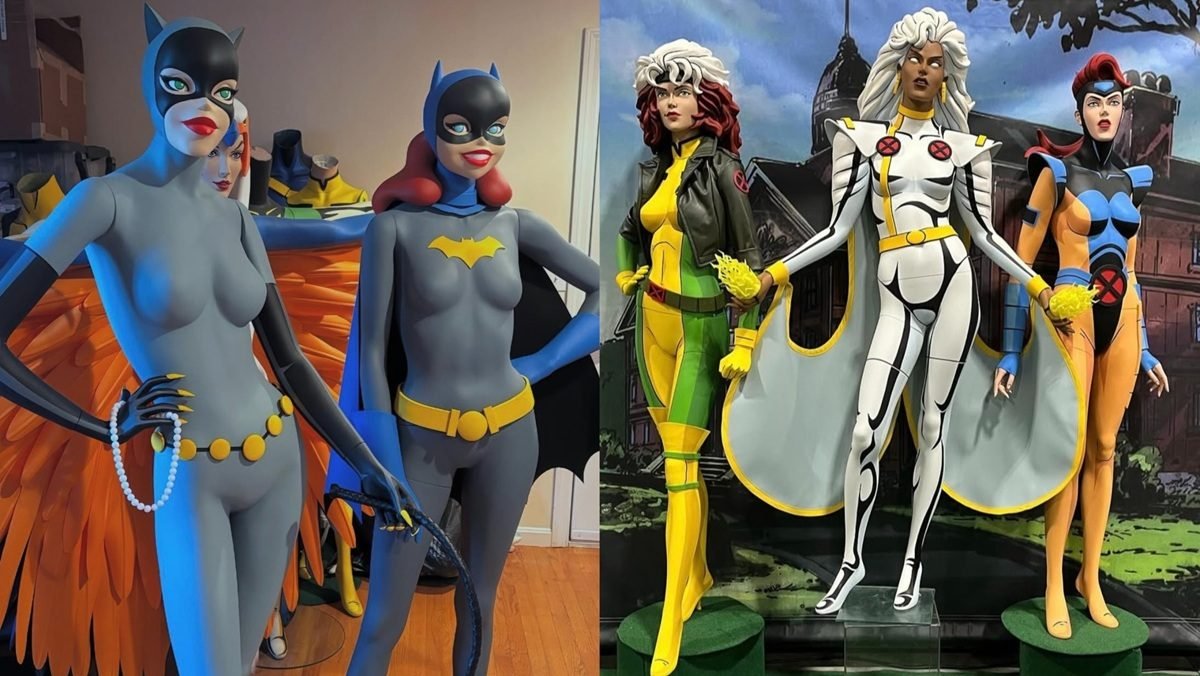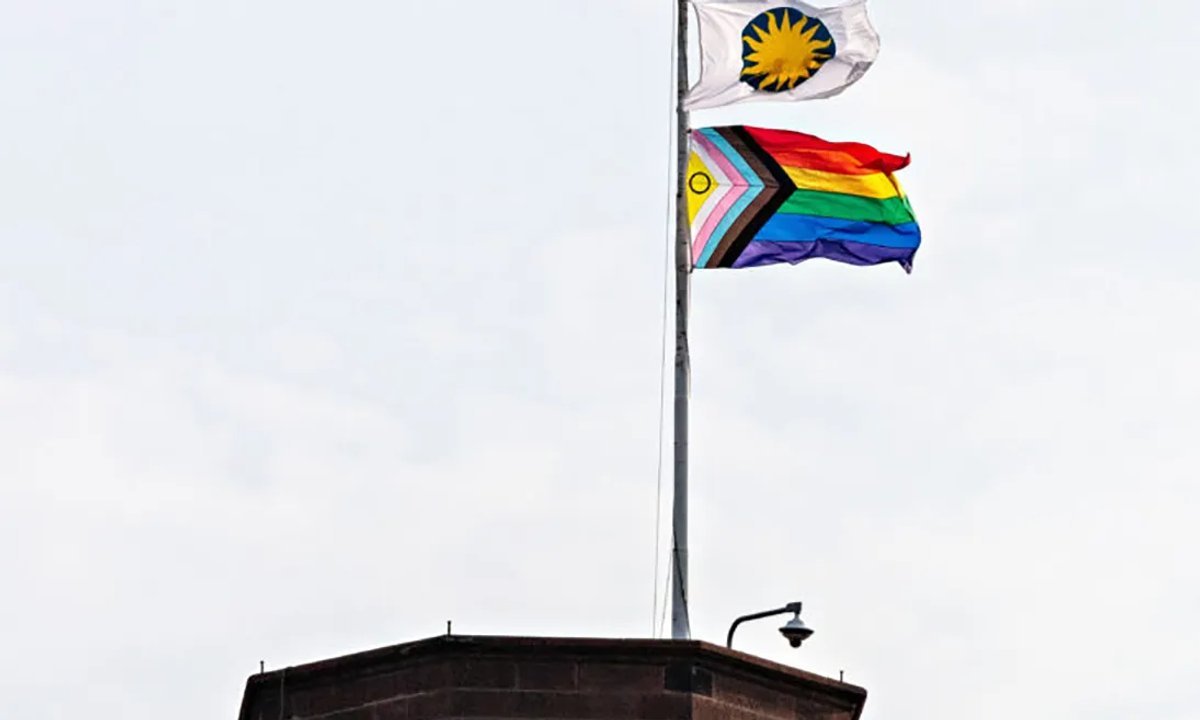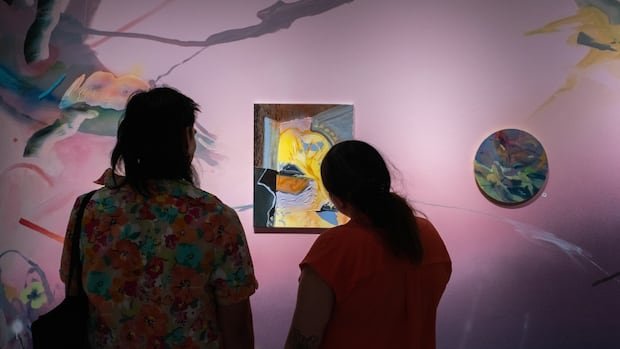It’s one of the great origin stories in contemporary art, a flash of instinct that would revolutionize a field. In 1998, El Anatsui was walking around Nsukka, Nigeria, and noticed a bag of aluminum bottle caps by the roadside.
Anatsui, then a professor at the University of Nigeria who was drawn to daily-life materials in his own art practice, took the bag to his studio. He began to play with the caps: folding them, slicing them in rounds and opening their cylindrical sides.
Working with assistants, he found a method. He punctured the metal bits in several places and linked them with copper wire. The compositional language rewarded scale: Soon individual works would enfold hundreds of thousands of these molecules. They would dance when hung on walls and cover entire buildings.
As they have awed viewers worldwide — at the Venice Biennale in 2007 or the Brooklyn Museum in 2013, for instance — Anatsui’s bottle-cap confections have defied description and category. Is he sculpting, or weaving? Is this art modern, abstract, universal, African?
The answer to all of these is: Yes.
This week, Anatsui’s latest monumental work opens in the cavernous Turbine Hall at Tate Modern in London. Titled “Behind the Red Moon,” it evokes the celestial and the maritime. Come down the entry ramp and an immense red-on-red sail with a central orb billows over your head. Its back unfurls in shades of yellow. At the far end, another sheet dips to the ground, dark like a looming shore. In between, panels of silvery diaphanous rings glitter in the light; they suggest human figures and come together to form a globe.
Twenty-five years after Anatsui’s roadside intuition, his bottle-cap compositions still reward and elude. Grand but down-to-earth, they exude sensuousness and sweep, yet, on approach, grow prickly and particular. They invite close looking — for the sheer craft, but also for insights, in their weave of recirculated materials, about the world we live in. With its navigational theme and the fact that it is on view in London, “Behind the Red Moon,” which Anatsui conceived working with the Tate curators Osei Bonsu and Dina Akhmadeeva, carries allusions to colonial trade and empire while operating through metaphor.
For the Princeton University art historian Chika Okeke-Agulu — an Anatsui expert who helped organize a major 2019 Munich retrospective — Anatsui has done nothing less than reinvent sculpture.
“When you look at these gossamer structures in space, monumental in scale yet so fragile, that paradoxical invocation of power and poetry, it’s hard to find equivalents,” Okeke-Agulu said. “It’s a completely new proposition.”
IN LATE AUGUST, I met Anatsui in the new studio he has built in Tema, the port city near Accra, Ghana’s capital. Born and raised in Ghana, Anatsui spent 45 years in Nigeria before returning two years ago.
Tema is a utilitarian place, a planned city with a container terminal, oil refinery and aluminum smelter. Anatsui’s studio sits near the main highway, neighboring low-slung warehouses, the truck yard for a cement company and a home-goods superstore. When I arrived, Anatsui, 79, was working with 10 assistants on new works.
Even a small Anatsui piece fetches hundreds of thousands of dollars; his metal works were among the first pieces of African contemporary art to clear the million-dollar bar, setting key market benchmarks and building value for cohorts of young artists behind him.
The proceeds sustain a whole economy. Anatsui’s materials are inexpensive, but he requires huge quantities. The work is immensely labor-intensive and now straddles two countries. Between Ghana and his larger studio in Nigeria, he employs nearly 100 people.
I watched Anatsui review sections of bottle-cap weave laid on the floor of a hexagonal atelier. Two assistants worked at a small table puncturing aluminum pieces with wood awls — the tedious fundamental labor.
The sections on the floor shimmered in gold, silver, purple, yellow. Some were streaked with contrasting colors and forms; others had multiple layers.
More developed pieces hung on the studio walls. As we considered a jagged rectangle composition about 10 feet wide, made of deep reds and softer pinks with an irregular gold central field, I asked Anatsui how he knew a work was finished.
“It has to hang on the wall a certain time and undergo scrutiny and reflection,” he said. He asked me to interpret the piece: “Can you see anything?”
I hesitated. “When people ask that, you will start to think there is something there,” he said. The work was entirely abstract. “There is nothing there.”
Anatsui, whom everyone calls “Prof,” is soft-spoken and witty. The more analytic the point, the more likely he will offset it with a chuckle or wry smile.
His art comes pre-loaded with meaning. Sorted into crates and sacks in the studio, the caps and foils — from alcohol, other drinks, medicines — suggest a kind of material sociology of daily life, consumption and commerce. He still obtains them mostly in Nigeria but is building his Ghana circuits; minor local differences in products and tastes could ramify through his artwork into new colors and patterns.
In societies where adaptive reuse is the norm, Anatsui rejects the premise of trash. Consider the foil buffet trays at weddings or funerals, he said, which can be smelted back into cooking pots. “We are not working with waste material, because there are other people who use them for other things,” he said. Art is one option in the cycle.
He is keenly conscious of his own work’s industrial organization — particularly now that its supply chain crosses countries. The Nsukka studio produces works up to the point where his eye and touch are needed. Folded into crates, they are shipped by DHL to Tema, from where the finished pieces head out into the world.
In designing the Turbine Hall work, Anatsui said, he had in mind the trans-Atlantic triangular trade in enslaved people and plantation commodities — particularly sugar, which built the wealth of Henry Tate, the museum’s 19th-century patron. In a sense, he said, Nsukka to Tema to London “replicates a triangle in the way the whole work comes about.”
But he keeps a space now at Tema port, to generate fresh ideas near the docks and vessels. The setting, he said, “offers new challenges and opportunities to me as an artist.”
THEY MISS HIM in Nsukka.
“You can say that again,” said Chijioke Onuora, a former student of Anatsui who is now a fine art professor at the University of Nigeria.
Anatsui arrived there in 1975 and became a fixture for 45 years. He impressed students with his nontraditional assignments, and by “doing the kind of art that was a little weird to us,” said Onuora, who studied with him in the early 1980s. “He would tell us to find something common and experiment with ways to make it into interesting sculptures.”
Nsukka, in eastern Nigeria, was no ordinary college town. After the Biafran war ended in 1970, it attracted intellectuals, notably the novelist Chinua Achebe. The painter and sculptor Uche Okeke oriented the university’s art program toward “natural synthesis,” his term for modern art that drew on local and traditional aesthetics and knowledge.
At a time when writers and artists around Africa craved ways to ally their colonially shaped training and study in the Western tradition with the local cultures it disparaged or ignored, Nsukka offered a community and institutional home.
Anatsui had trained conventionally, at a university in Ghana. But in the early 1970s, while teaching in Winneba, a coastal town west of Accra, he began working on round wooden trays that were common in markets there, and into which he began burning his adaptations of Adinkra symbols, which express social concepts and proverbs.
When Anatsui joined the faculty in Nsukka, his art grew to encompass many media — wood, ceramics, printmaking. He created wood pieces lined up like xylophone keys that could be shown in many sequences, which earned him notice abroad — including the 1990 Venice Biennale. He broke and reassembled ceramic vessels. He made art from local practical objects, including wood mortars and iron cassava graters.
Thanks to Anatsui, Onuora said, “it dawned on everybody that anything at all could be used to make a sculptural statement.”
Anatsui’s international visibility, which grew in the 1990s before the bottle-cap works turbocharged it, offered ballast against the vagaries of Nigeria — the years of dictatorship and economic crisis that pushed many peers and students to emigrate. Nevertheless, Anatsui told me, he bought land in Ghana as early as 1999, sensing the time would come.
In Nsukka, Onuora said, the view was that Anatsui might never have left, were it not for escalating insecurity in the region, notably kidnappings for ransom.
But when I asked Anatsui what motivated his decision, he emphasized the importance of change, and the duties of age. “As an artist, you need to have a variety of experiences,” he said. “And growing old, you need to establish something at home. ”
THE NEXT DAY, I met Anatsui on the Accra-Tema highway, well before dawn to beat the traffic. We were headed to Anyako — his ancestral town, where he was born, on a lagoon peninsula near the border with Togo.
Anatsui is investing. In Tema, a huge studio extension, two-thirds the size of a football field, is nearly complete. It will have areas for wood sculpture — which Anatsui never stopped doing — and metal, ceramics, even a sound studio.
But in Anyako his mission is personal. Even as a child, he told me, he was rarely there, because he was raised by an uncle who was a pastor in other towns. He did not know much about home, he said, but was always soothed by the breeze on the lagoon.
Now he shows up — to the weddings, the funerals, the naming ceremonies. He has purchased land next to a nephew’s home — Anatsui himself is a lifelong bachelor — and intends to build a cultural center. The lagoon is overfished, unemployment is soaring; culture, he said, should bring value.
“Before long I’ll be living here,” he said. “It’s not good to just come and live in the world and go, and not leave any contribution.”
At the waterside we entered long wood canoes and crossed the lagoon. Returning, we had the wind at our backs. The boatmen roped the canoes together, then raised a mast — a Y-shape arrangement of two branches — and a sail made from flour sacks.
Nothing was wasted. The perfect sculpture billowed us home.






